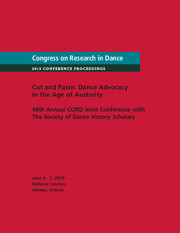Article contents
She's Beauty and She's Grace(less): The Mercurial Femininity of the Modern Disney Princess
Published online by Cambridge University Press: 02 August 2016
Abstract
Focusing on characters from Disney's three most recent “princess” films, Tangled (2010), Brave (2012), and Frozen (2013), I examine the development and divergence of these figures from “classic” Walt Disney models. Their mercurial character, as illustrated through gesture and movement, presents a firm contrast with and significant departure from their predecessors in films such as Cinderella (1950) and Sleeping Beauty (1959)—protagonists who exhibited a static character reflective of their social roles through the “embodiment” of balletic grace. Expanding on existing research comparing Walt Disney–era princesses with those from the Disney Renaissance of the 1980s and 1990s, I explore the significance of this shift in representation. Viewed as a metaphor for contemporary femininity, how do these modern princesses resolve the incongruity between their official social stations, proscribed behavior, and “real” personalities through their bodies over the course of the films?
I believe that the conflict staged on these animated bodies is representative of larger societal issues emerging from contested definitions of both feminism and femininity, and that the Disney princess offers a contemporary site for the expression and resolution of this dissonance. Viewing the body of the Disney princess as representative of a larger female “social body” and conflict that occurs within her as indicative of the larger forces that shape female identity, I integrate my study with historical dance scholarship which regarded movement as indicative of the presence of an Apollonian/Dionysian dialectic working within culture.
- Type
- Research Article
- Information
- Copyright
- Copyright © Michelle Johnson 2016
References
Works Cited
- 1
- Cited by


